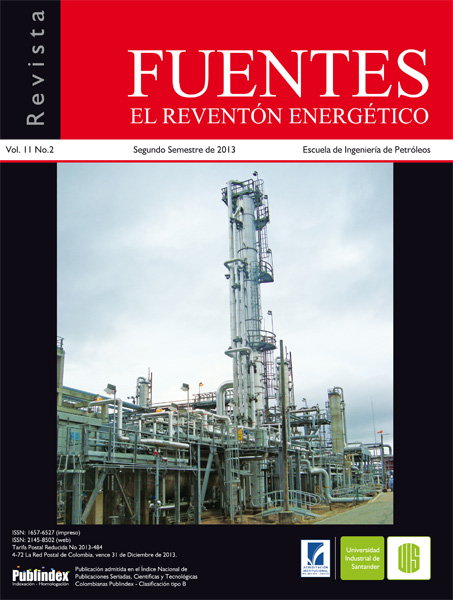Study of the influence of an external electric field on the mobility of paraffinic crude oils
Published 2013-12-23
Keywords
- Paraffin-base crude oil,
- wax precipitation,
- electric field,
- viscosity,
- cloud point
- pour point ...More
How to Cite
Abstract
The purpose of this study was to determine the feasibility of using electric fields as a method for to inhibit the formation of paraffin deposits in the production and transport of paraffinic crude oils. a capillary viscometer was designed and constructed, and then adapted to an electric field generator. This experimental setup allowed generating electric fields of different amplitudes. Capillaries tubes of different diameters were used in order to obtain different exposures times of the oil to the electric field. The variables used to quantify the effect of the electric field on the oil were the mass flow, viscosity, cloud point, and pour point. The experimental data shows that the application of the electric field to oil from Colorado 67 and Colorado 36 wells resulted in an increase of viscosity, cloud point, and pour point. These results suggest that exposure of oil to the electric field accelerates the precipitation process of organics and therefore it is not recommended for implementation in the studied wells.
Downloads
References
2. TaO, R. final report: Reducing the viscosity of crude oil by pulsed electric or magnetic field. Department of Physics, Temple university Philadelphia, Philadelphia, USA, 2008.
3. TaO, R. The physical mechanism to reduce viscosity of liquid suspensions. International Journal of Modern Physics B. 2007, vol 21, p. 4767-4773.
4. EVDOKIMOV I. et al. Apparent disaggregation of colloids in a magnetically treated crude oil. Energy & fuels. 2009, vol 23, p. 4016-4020.
5. TanG H. et al. Electro rheology improves transportation of crude oil. Journal of Intelligent Material Systems and Structures. 2011, vol 22, p. 1673-1676.
6. ZHanG J. et al. The electrorheological effect study of crude oil under the applied electric field. Physical and Numerical Simulation of Geotechnical Engineering 2nd ISSUE. China, 2011.
7. LESS S. et al. An electro rheological study on the behavior of water in crude oil emulsions under influence of a DC electric field and different flow conditions. Journal of Dispersion Science and Technology. 2008, vol 29, p. 106-114.
8. GONCALVES, J. et al. Study of the factors responsible for the rheology change of a Brazilian crude oil under magnetic fields. Energy & fuels, 2011, vol 24, p. 3144-3149.
9. ARIZA, E. Determinación del umbral de cristalización de las parafinas en el crudo del Campo Colorado. Tesis de Maestría. universidad industrial de Santander, Escuela de Ingeniería de Petróleos, 2008.
10. VILLABONA C. y GONZALEZ G., D. Mejora de la movilidad del crudo parafínico mediante campos magnéticos. Trabajo de Grado. Director: Hermann Raul vargas Torres, universidad industrial de Santander, Escuela de Ingenierías Eléctrica, Electrónica y Telecomunicaciones, 2009.
11. OuTLaW J. et al. Wax appearance temperature detection by DSC. Application note, Perkin Elmer, Inc., 2011.
12. MOnTGOMERY, D. Diseño y análisis de experimentos. 2 ed. México, D.F.: Grupo Noriega Editores, 2004. ISBN 968-18-6156-6.
